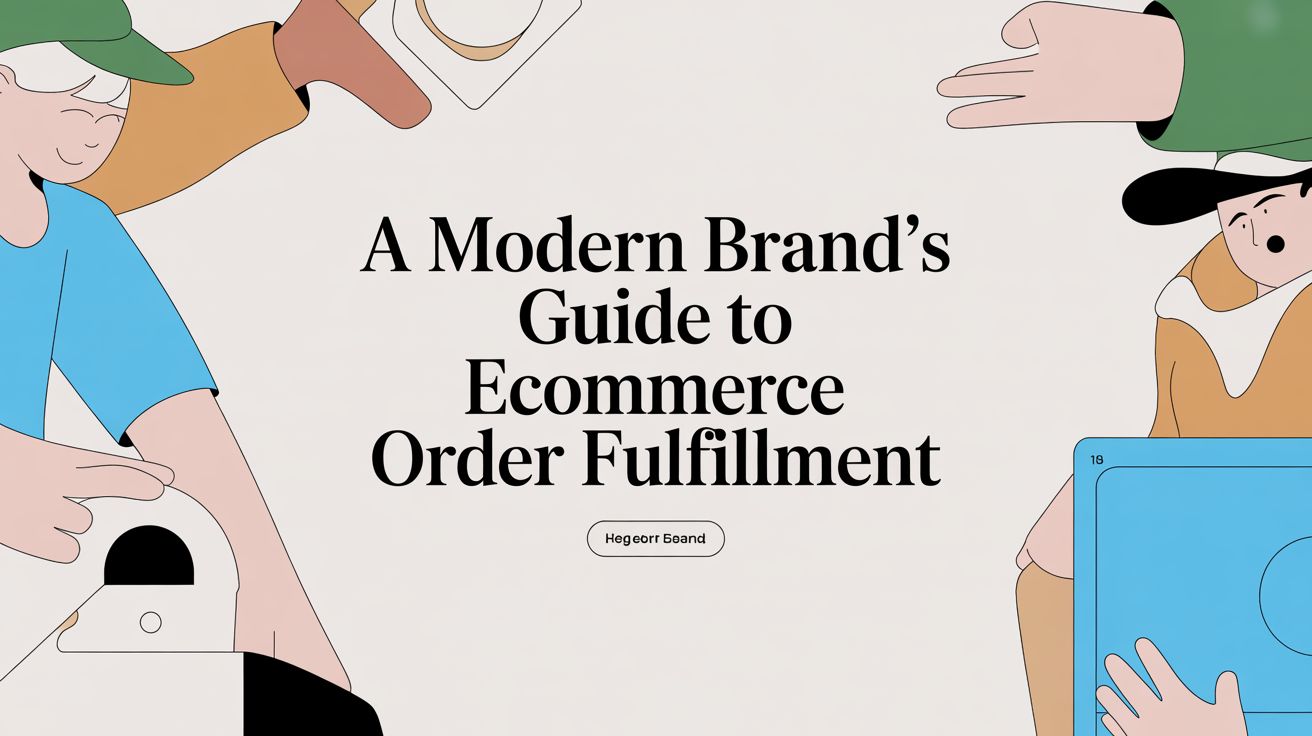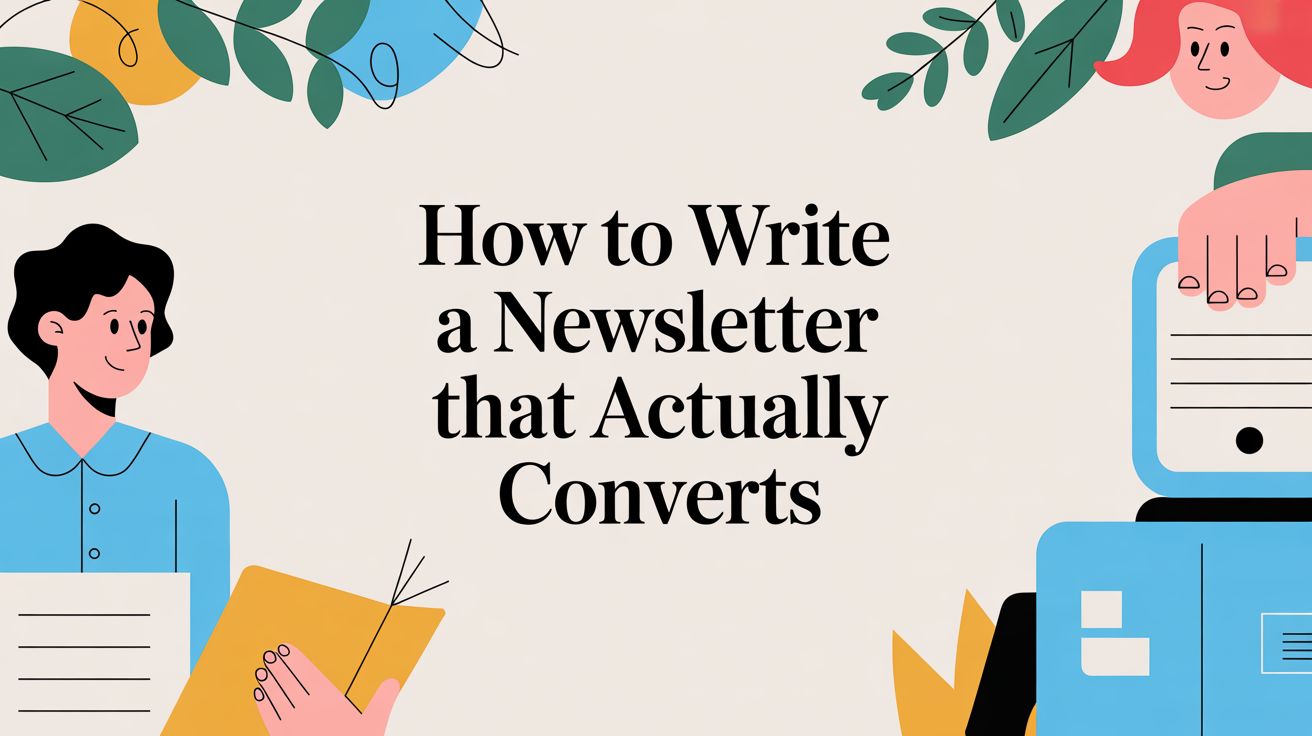
The Small Business Guide to Marketing Automation That Drives Revenue
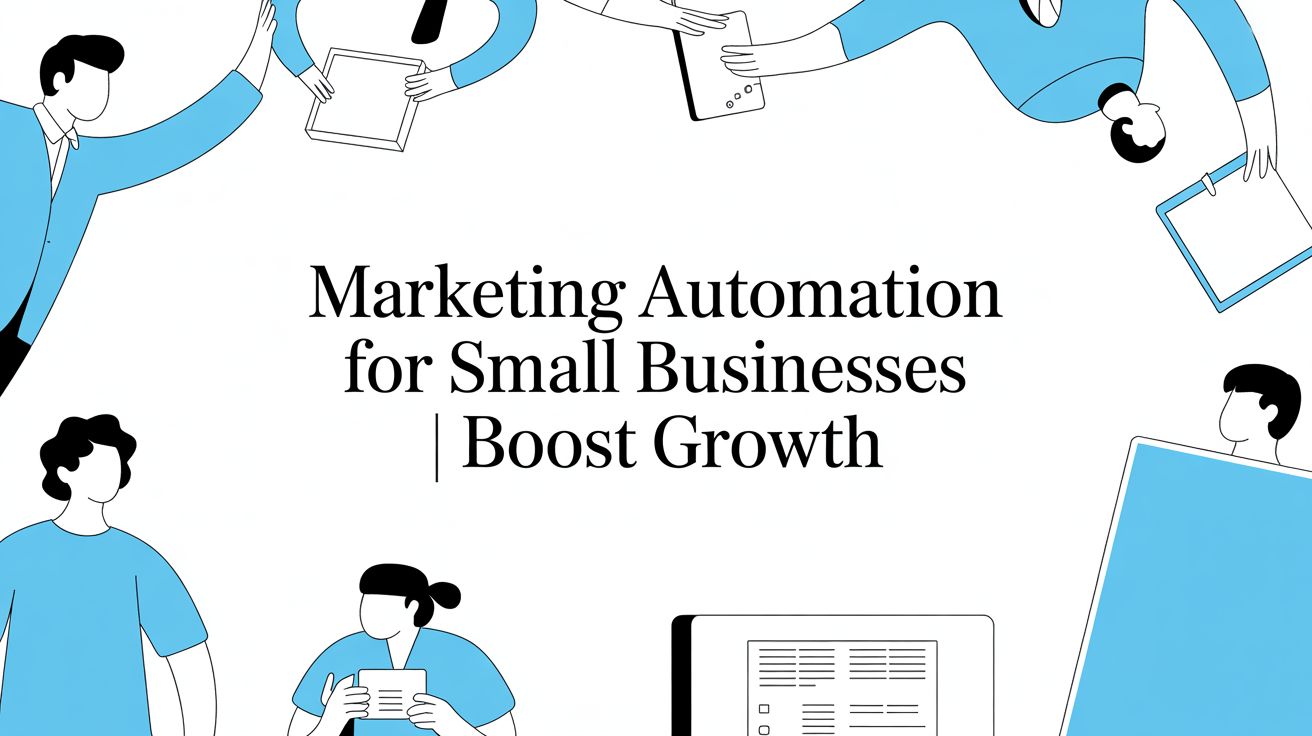
Marketing automation often sounds like a complex strategy reserved for large corporations with massive budgets. However, it's actually one of the most impactful tools a small business can leverage for growth and profitability.
At its core, marketing automation is about using intelligent technology to handle repetitive marketing tasks. This includes everything from sending welcome emails and social media posts to following up on sales leads. By automating these processes, you can create personalized, timely experiences that convert prospects into customers—all without manual intervention. This frees you and your team to focus on what truly matters: strategy, customer relationships, and scaling your business.
How Automation Creates Growth for Small Businesses
As a small business owner, you wear many hats: CEO, marketer, sales lead, and customer service representative. Juggling these roles is demanding and leaves little time for strategic initiatives that drive sustainable growth.
This is precisely where marketing automation provides a competitive edge. It’s not just complex corporate software; it's your most efficient team member.
Think of it as a digital assistant working 24/7, handling critical yet time-consuming tasks. It sends the perfect welcome email the moment a customer signs up, reminds another about items left in their cart, and nurtures new leads with valuable content. This frees you from the daily operational grind to focus on the big picture, like building authentic customer relationships or planning your next product launch. This shift from tactical work to strategic planning is the foundation of scalable revenue growth.
This infographic illustrates how automation functions as that digital assistant, clearing your schedule to focus on activities that drive real business impact.
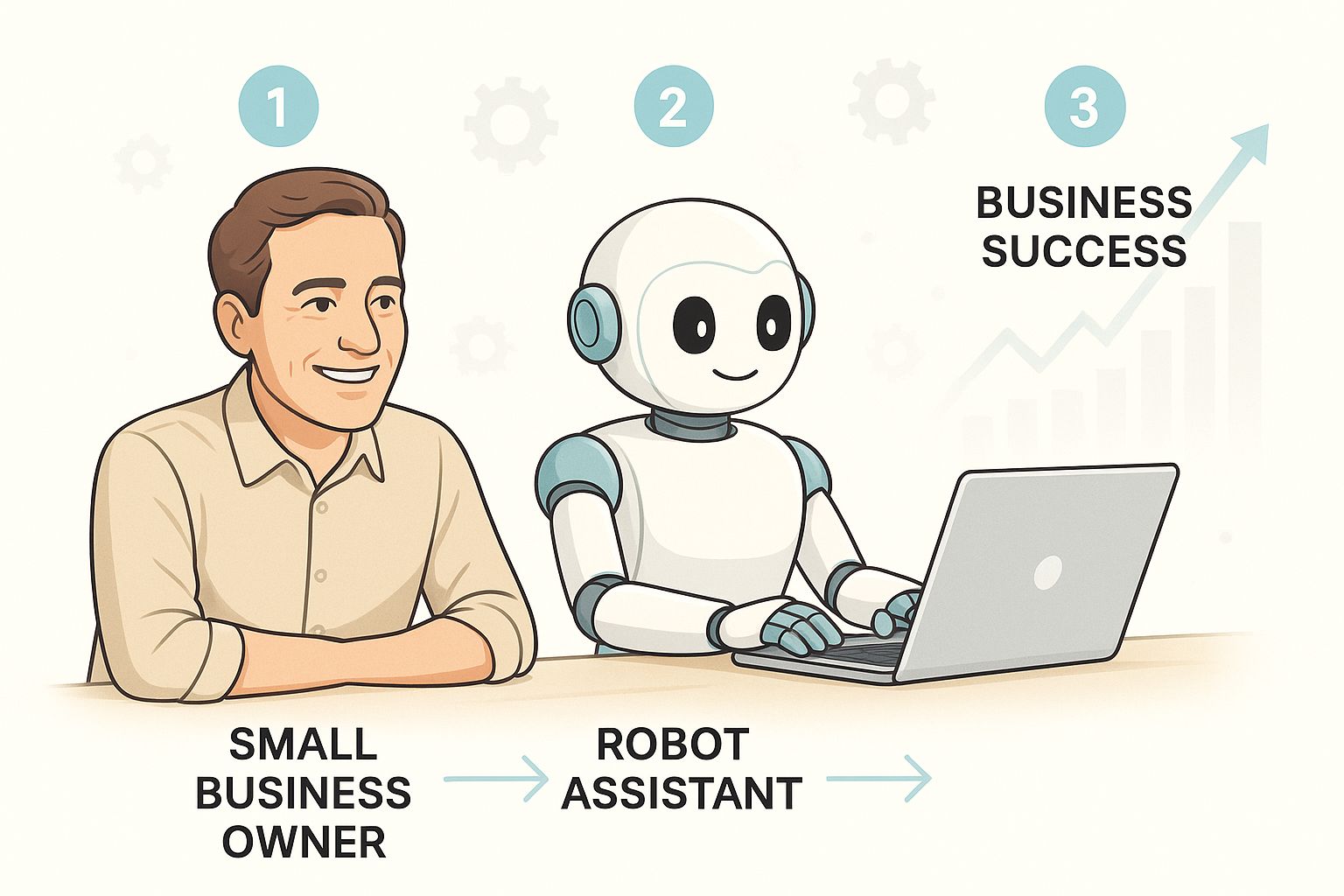
As you can see, it’s all about transforming manual work into a self-sustaining engine for revenue and profit.
Leveling the Playing Field
Competing with corporate giants can feel like a David vs. Goliath scenario. Marketing automation is your slingshot. It empowers you to deliver consistent, personal, and perfectly timed messages at a scale you could never achieve manually.
This consistency builds trust, keeps your brand top-of-mind, and makes your small business appear as professional and capable as its largest competitors.
The real magic of automation is that it executes your best marketing strategy flawlessly, every single time. No lead is forgotten. No customer is left hanging. It transforms your manual, often chaotic, processes into a reliable machine built for growth.
This is a fundamental shift in business operations. Small businesses embracing AI-powered automation are seeing tangible results—in fact, they are 63% more likely to outperform their competitors. Why? Because automation facilitates hyper-personalized content for every customer, which is now a baseline expectation. You can dive deeper into these marketing automation statistics and their impact on business growth.
More Than Just Saving Time
While reclaiming hours in your week is a significant benefit, the true power of marketing automation for small businesses lies in its direct impact on your bottom line. By automating your lead nurturing process, you create a guided path that moves potential customers from initial interest to purchase.
Here’s a quick look at how that plays out:
- Capture and Engage: A visitor lands on your Shopify store and subscribes to your newsletter. Instantly, your automation platform—integrated with Klaviyo or your preferred email service—sends a warm welcome email, perhaps with a compelling offer to encourage their first purchase.
- Nurture and Educate: Over the next few weeks, the system automatically delivers genuinely useful content—blog posts, guides, or tips—all relevant to their initial interest. You're building a relationship based on value, not just sales pitches.
- Convert and Retain: The moment they exhibit buying intent (like visiting a product page multiple times), the automation can trigger a targeted follow-up email. This is where advanced platforms move beyond simple timers; they use behavioral psychology, like anticipating purchase intent, to deliver the right message at the peak of interest.
This isn't random email blasting. It's a sophisticated, cohesive strategy that turns your marketing efforts into an efficient engine designed for one thing: sustainable, predictable revenue.
Key Automation Benefits for Small Businesses at a Glance
To understand the immediate value, it helps to see the core benefits laid out simply. This table breaks down exactly how automation can change the game for a small operation like yours.
| Benefit | Impact on Your Small Business |
|---|---|
| Time Savings | Frees you from repetitive tasks like sending emails and social posts, giving you more time for strategy and customers. |
| Increased Revenue | Nurtures leads automatically based on behavioral triggers, guiding them toward a purchase and increasing lifetime value. |
| Better Leads | Helps score and prioritize leads, focusing sales efforts on prospects with the highest purchase intent. |
| Improved ROI | Delivers measurable results, allowing you to see exactly which marketing activities are driving revenue and profit. |
| Enhanced Engagement | Sends personalized, relevant content at the right time, leveraging principles like anticipation and social proof to build loyalty. |
Ultimately, each of these benefits works together, creating a powerful system that not only makes your life easier but also builds a more resilient and profitable business.
Essential Automation Workflows That Drive Sales
Theory is valuable, but let's focus on what truly matters: driving a direct impact on your revenue. It's easy to get lost in the possibilities automation offers. The most effective approach for any small business is to focus on a few core workflows that are proven to generate ROI.
Think of these workflows as your best salespeople, working 24/7. Each is triggered by a specific customer action, follows a series of logical steps, and has a clear goal—moving a potential customer closer to a purchase. They are the engine of a solid automation strategy, moving beyond the basic email capture of simple pop-ups to true revenue generation.
Most platforms make this incredibly easy by providing pre-built templates, or "recipes," so you don't have to start from scratch.
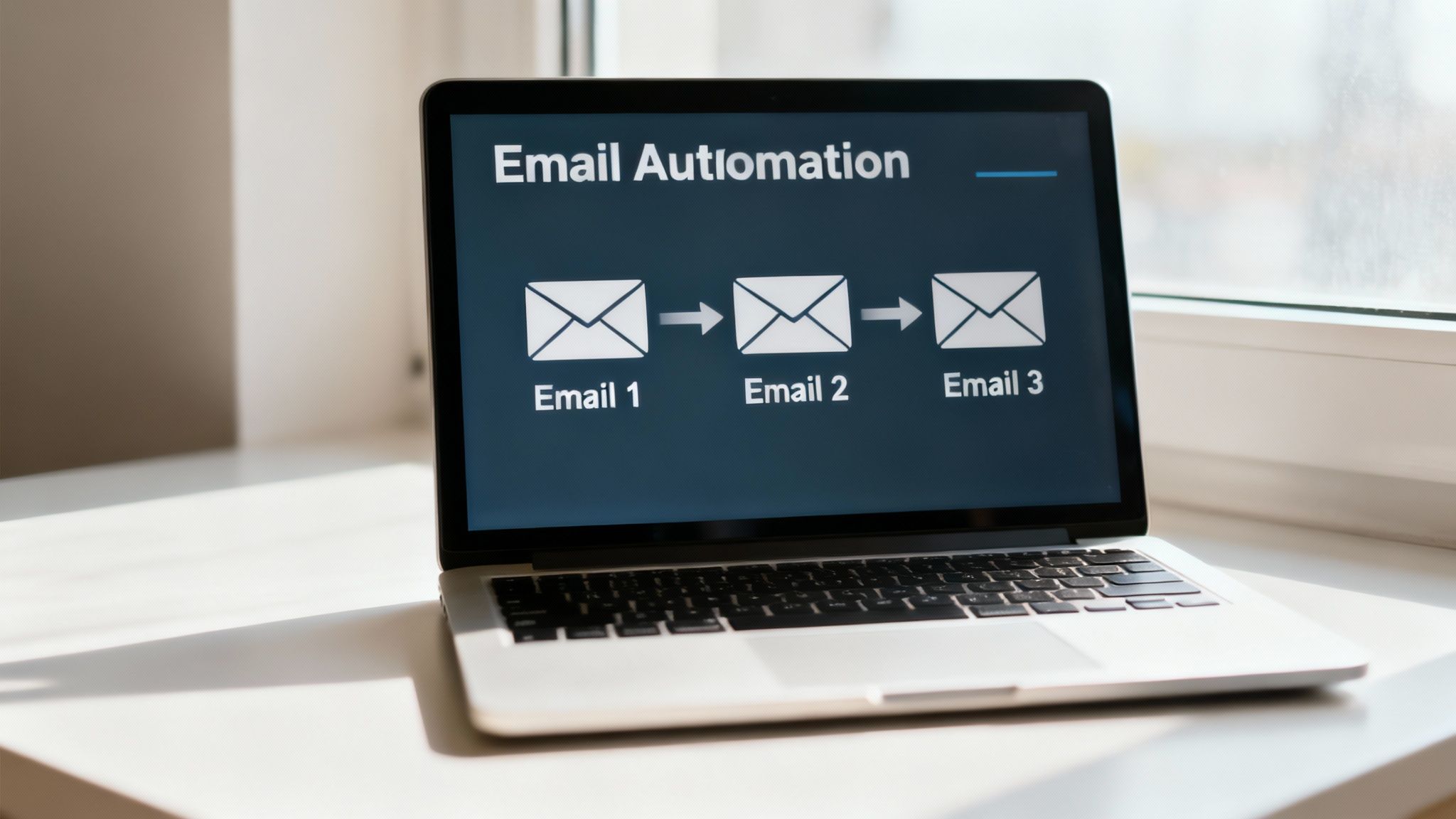
As you can see, you can grab ready-to-use sequences for everything from welcoming new subscribers to winning back customers who have gone quiet.
The Welcome Series: Nurturing New Leads
First impressions are critical, especially online. A welcome series is a sequence of emails automatically sent the moment someone subscribes, downloads a resource, or creates an account. This is your golden opportunity to connect while their interest is at its peak.
The goal isn’t just to say, “Thanks for signing up.” It’s about introducing your brand, setting expectations, and gently guiding new leads toward their first purchase.
A simple but highly effective welcome series might look like this:
- Email 1 (Instantly): A warm welcome that confirms their subscription and delivers any promised incentive (like a discount code).
- Email 2 (2 days later): Share your brand's story. People connect with people, so sharing your mission builds trust and differentiates you.
- Email 3 (4 days later): Showcase your best-selling products. Incorporate social proof, like customer testimonials, to build credibility and tap into the psychological principle of consensus.
- Email 4 (7 days later): A final, friendly nudge about their welcome offer if unused. This creates a sense of scarcity to encourage action.
This sequence transforms a cold lead into a community member, priming them to become a loyal, high-value customer.
Abandoned Cart Recovery: Reclaiming Lost Revenue
Did you know the average cart abandonment rate is nearly 70%? That represents a staggering amount of potential revenue left on the table. An abandoned cart recovery workflow is one of the single most profitable automations you can implement.
Abandoned cart emails have an impressive average open rate of over 40% and a click-through rate of over 20%. It’s a direct, immediate, and incredibly effective way to recover lost sales and boost your bottom line.
This workflow is triggered when a user who has provided their email adds items to their cart but leaves your site before completing the purchase.
Here’s a typical three-part recovery sequence:
- Email 1 (1 hour later): A friendly reminder: "Did you forget something?" Keep it simple and helpful, with images of the items and a direct link back to their cart.
- Email 2 (24 hours later): Address potential hesitation. Feature product reviews (social proof), highlight your return policy, or offer support to reduce friction.
- Email 3 (48-72 hours later): Create urgency. A limited-time offer, like a small discount or free shipping, can trigger the principle of FOMO (Fear Of Missing Out) and motivate them to complete the purchase.
The Lead Nurturing Workflow: Guiding Prospects to Purchase
Not every prospect is ready to buy immediately. Many are in the research phase, and a lead nurturing workflow is your tool for guiding them toward a decision without being pushy. This is where you establish your brand as an authority.
This workflow typically starts when someone shows deeper interest, like downloading a buyer's guide. The key is to provide value, not a sales pitch. Using smart segmentation, you can send content that is highly relevant to their interests. To dig deeper into this, check out these different customer segmentation examples in our guide.
Your nurturing sequence is about education and trust-building. You could send:
- Helpful blog posts related to their interests.
- Case studies or success stories demonstrating your product's value.
- Invitations to webinars or video tutorials.
- Answers to common questions about the product.
By educating your prospects, you build a relationship. When they are finally ready to buy, your brand will be their first choice.
Boosting Revenue and Protecting Profit Margins
Saving time is a fantastic perk, but the real story behind marketing automation for small businesses is its direct and undeniable impact on your bottom line. It's not just about doing things faster; it's about executing smarter strategies that generate measurable revenue and protect your profit margins.
Automation shifts your team's focus from tasks that cost money to activities that make money. Instead of being bogged down in manual email sends, they can focus on building relationships with high-value leads or crafting irresistible offers. It transforms from a simple tool into an engine for profitable growth.
From Time Saved to Revenue Gained
How exactly does this translate into more money? It's about plugging leaks in your sales funnel. By establishing consistent, timely touchpoints for every lead, you prevent potential customers from falling through the cracks. Every prospect is nurtured according to your best strategy—every single time.
This systematic approach is a game-changer for small teams. When you automate lead qualification and follow-up, your sales team engages only with warm, educated leads who are much closer to making a purchase decision.
The core financial benefit of marketing automation is simple: it turns time into money. Every hour saved is an hour you can reinvest into big-picture strategy, stellar customer service, or product innovation—activities with a far greater return than manual data entry.
The numbers support this. Research shows automation can boost sales productivity by 14.5% and reduce marketing overhead by about 12.2%. Furthermore, automated email workflows significantly outperform standard campaigns, with top-performing sequences generating up to $16.96 per recipient. This dwarfs the average $1.94 from a one-off email blast. You can dig into more of these marketing automation statistics to see the full financial picture.
Protecting Your Profit Margins
Generating new sales is only half the battle; protecting your existing profit is equally crucial. Automation is one of your best defenses against margin erosion. Every manual task carries a cost, not just in salary but also in the risk of human error. A mistyped discount code or a forgotten follow-up can directly impact revenue.
By standardizing processes, automation minimizes these risks. It brings a level of consistency that prevents costly mistakes and ensures a professional customer experience. Consider the cost of employee turnover in a marketing role—a well-built automation system retains that strategic knowledge and continues executing flawlessly. This is especially vital for inventory management, as automated promotions can help move stock efficiently without deep, profit-killing discounts.
Here’s a quick breakdown of how automation guards your bottom line:
- Reduces Labor Costs: It handles the repetitive work of a junior marketer without the associated salary and overhead.
- Minimizes Errors: Automated systems don't make typos or forget to send crucial messages, preventing lost sales and customer frustration.
- Improves Resource Allocation: It frees up your team and budget to focus on high-ROI projects that drive strategic growth.
By cutting down on manual, error-prone tasks, you create a leaner, more efficient business. That means more of every dollar earned goes straight to your profit margin, building a healthier and more resilient company.
Choosing the Right Marketing Automation Platform
Selecting your first marketing automation platform can feel overwhelming due to the vast number of options available.
The secret isn't finding the single "best" platform; it's about finding the one that best fits your business—your budget, your team's technical comfort level, and your specific goals.
Getting this right is a strategic move that will deliver returns for years. The wrong choice leads to frustration, wasted money, and a powerful tool that goes unused. Let's break down how to find a platform that feels like a new member of your team.
Core Criteria For Your Decision
Before getting distracted by features, ground your search in four key areas. These pillars will support your decision, ensuring you pick a tool that grows with you.
Ease of Use: As a small business owner, your time is invaluable. Look for a clean, intuitive interface, drag-and-drop workflow builders, and dashboards that provide clear insights at a glance. A platform that requires extensive training will slow you down.
Integration Capabilities: Your automation tool must work seamlessly with your existing tech stack. For any e-commerce brand, this means robust, one-click integrations with platforms like Shopify or Shopify Plus, and email and SMS tools like Klaviyo.
Scalability: The platform that fits your budget today must also support your vision for the future. Examine its pricing tiers and feature sets. Does it offer more advanced capabilities you can grow into without the pain of migrating all your data?
Transparent Pricing: Hidden fees and confusing credit systems can turn an affordable tool into a budget-buster. Look for clear, predictable pricing models so you can accurately forecast your marketing spend and ROI.
Matching The Platform To Your Business Model
Not all automation software is created equal. Different platforms are designed for specific business types. Instead of getting lost in feature comparisons, start by identifying which category your business falls into.
A common mistake is choosing a platform because it's popular, not because it's a good fit. A tool built for a B2B sales funnel will feel clunky for a fast-moving Shopify store. Aligning the tool's core strengths with your business model is the crucial first step.
When this alignment is right, you'll find the platform's features—from its e-commerce triggers to its segmentation capabilities—are designed to solve your specific challenges.
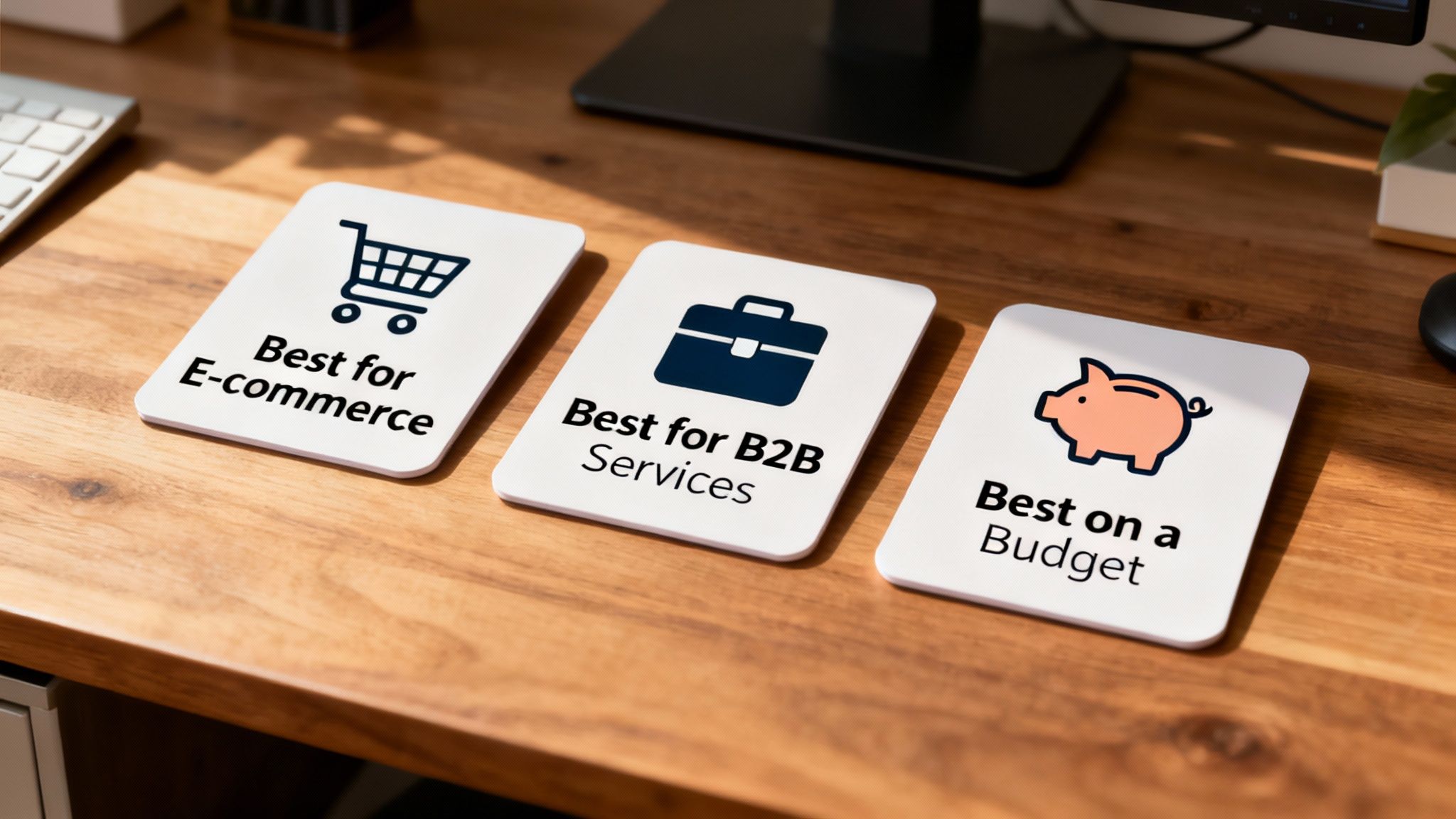
Best Platform Categories For Small Businesses
To cut through the noise, we've grouped top options into categories based on small business needs. For a deeper dive into specific brands, check out our comprehensive guide to the best marketing automation tools available today.
Here’s a quick-glance table to help you get your bearings and start your research.
Top Marketing Automation Tools for Small Businesses
A head-to-head look at the most popular marketing automation platforms, broken down by what really matters for small businesses: their strengths, key features, and what they'll cost you.
| Platform | Best For | Key Features | Starting Price |
|---|---|---|---|
| All-in-One CRMs | Service-based businesses (B2B) that need deep sales and marketing alignment. | Advanced lead scoring, deal pipelines, and comprehensive contact management. | $50 - $150/month |
| E-commerce Focused | Online stores, especially those on Shopify or similar platforms. | Deep e-commerce integration, abandoned cart recovery, and product-based segmentation. | $20 - $100/month |
| Email-Centric | Content creators, bloggers, and businesses with a simple sales process. | Strong email marketing features, straightforward automation, and landing pages. | $0 - $50/month |
This framework should help you zero in on platforms genuinely built to help a business like yours. By taking a targeted approach, you'll save time and feel confident that you’re making a smart investment that will become the engine for your future marketing efforts.
Launching Your First Automation Campaign
Getting started with marketing automation can feel like a huge undertaking. The secret? Start small and aim for a quick, measurable win. Don't try to automate your entire marketing strategy from day one. Instead, pick a single, high-impact campaign to get started.
This approach lets you prove the concept, see a clear return on investment (ROI), and build the confidence to scale up. The goal is to build one efficient, revenue-generating machine that works for you in the background.
Let's walk through a step-by-step framework to get your first workflow live and delivering results.
Step 1: Define a Specific, Measurable Goal
Before you touch any software, you must know what you're building for. A vague goal like "get more sales" is ineffective. You need a specific, measurable objective tied directly to a business outcome. This clarity will guide every decision you make.
Great goals for a first campaign often focus on high-value customer actions.
- For E-commerce: "Increase repeat purchases from first-time buyers by 15% within 60 days."
- For Service Businesses: "Convert 10% of guide downloads into booked consultations within 30 days."
Starting with a clear, quantifiable target transforms your automation from a simple task-doer into a strategic asset accountable for its performance.
Step 2: Choose Your Audience and Trigger
With your goal locked in, pinpoint the exact group of people you want to reach. Great automation is about sending the right message to the right person at the right moment. This starts with smart segmentation. A well-defined audience ensures your messages resonate instead of feeling like spam.
Next, you need a trigger—the specific action that initiates your automated sequence.
Think of the trigger as the starting pistol for your workflow. It's the moment a customer signals their interest, giving you the perfect opening to engage them with a personalized journey. This is behavioral marketing in its purest form: responding to what your users do in real-time.
For instance, if your goal is to tackle cart abandonment, your audience is "shoppers who added an item to their cart," and the trigger is "starts checkout but doesn't complete the purchase within one hour." If you're still working on growing your contact list, our guide on building an email list has some actionable strategies to get you started.
Step 3: Design the Workflow Logic
Now for the fun part: mapping out the customer journey. A workflow is a sequence of actions and delays designed to guide someone from the trigger to the goal. Simplicity is key. Your first workflow doesn't need ten complicated branches; it just needs to work.
A classic welcome series for a new subscriber is a perfect example:
- Trigger: A user subscribes to the newsletter.
- Immediate Action: Send "Welcome Email" with the promised discount code.
- Wait: Delay for 2 days.
- Action: Send "Email 2" sharing your brand story and highlighting top-rated products.
- Wait: Delay for another 3 days.
- Action: Send "Email 3" with customer testimonials and a friendly reminder about their unused discount.
This logical flow ensures each message builds on the last, creating a connected experience that nurtures the new lead without overwhelming them.
Step 4: Write Compelling Copy and Set Up Tracking
Your workflow's logic is the skeleton; your copy brings it to life. Every email or text needs a clear purpose. Are you trying to educate, build trust, or drive a click? Be concise, personal, and action-oriented. Write like a human, focusing on their needs, not just your product's features.
Finally, before launching, ensure your tracking is in place. Set up conversion goals within your automation platform to measure success. This isn't just about tracking opens and clicks—it's about tracking the actual revenue the campaign generates. That is the only way to calculate your ROI and prove that your marketing automation for small businesses is putting real money back into your pocket.
Where Small Business Automation is Headed Next
Marketing automation is not a static technology; it's constantly evolving to become smarter, more intuitive, and more powerful. For small businesses, this represents a genuine opportunity to compete at a level previously reserved for large enterprises with massive budgets.
The next wave of automation is here, powered by artificial intelligence and predictive analytics.
We are moving far beyond simple "if this, then that" rules. It’s no longer just about sending an automated email after a cart is abandoned. Modern systems are smart enough to predict which customers are most likely to abandon their carts in the first place. That completely changes the game from reactive to proactive marketing.
The Rise of Predictive and Generative AI
The most significant shift is the integration of Artificial Intelligence (AI) into automation platforms. This isn't a futuristic concept; it's happening now and making sophisticated marketing tactics accessible to everyone.
AI is emerging in two major ways:
- Predictive Analytics: This is your strategic crystal ball. AI algorithms analyze your customer data to forecast future behavior. This enables predictive lead scoring to identify your hottest leads or spot customers at risk of churning before they leave.
- Generative AI: This technology helps you create deeply personalized content at scale. Imagine emails where the subject line, product recommendations, and even the tone of voice change dynamically to match each individual's browsing history and past behavior.
The core idea is to shift from reactive to predictive marketing. Instead of merely responding to what your customers did, you can start anticipating what they will do next. This allows you to create a buying journey that feels truly personal and effortless.
This intelligent automation is quickly becoming essential for growth. The market is projected to reach $15.62 billion by 2030. For small business owners, this means more powerful tools are becoming available at affordable prices. You can learn more about how AI and predictive analytics are driving this growth.
Adopting automation is no longer just about saving time. It’s about future-proofing your business with the strategic tools needed to stay competitive in a world that rewards speed, personalization, and intelligence.
Got questions about marketing automation? Most small business owners do. Let's tackle some of the most common ones so you can feel confident getting started.
How Much Time Does It Take to Start?
Probably less than you think. You can get your first high-impact campaign—like a welcome series for new subscribers or a cart abandonment workflow—up and running in a single afternoon.
Most modern platforms are designed for business owners, not developers. They feature intuitive, drag-and-drop builders and pre-made templates that eliminate technical guesswork.
The key is to start small. Pick one goal, build one workflow, and let it run. Once that machine starts saving you time on manual follow-ups, you can reinvest that time into building the next one. This creates a virtuous cycle of efficiency.
Will Automation Make My Brand Feel Impersonal?
This is the biggest myth about automation, stemming from a misunderstanding of what good automation does. Poorly executed automation is certainly impersonal. We've all received those generic, tone-deaf emails.
However, smart automation is the opposite. It uses behavioral data—what a customer actually does on your site—to deliver a hyper-relevant, one-to-one experience that would be impossible to manage manually. Advanced urgency marketing, for instance, is sophisticated psychology, not manipulation. It taps into principles like scarcity and anticipation to enhance the shopper's journey.
Effective automation doesn't replace the human touch; it creates more opportunities for it. By handling the repetitive tasks, you free yourself up to have real, meaningful conversations with your most engaged customers. It makes your brand feel more personal, not less.
Think about it: sending a generic blast to your entire list feels cold. But automatically sending a helpful guide to someone right after they downloaded a related resource? That's just thoughtful and effective marketing.
How Do I Measure the ROI?
This is one of the best parts. Measuring the ROI of marketing automation is much more straightforward than with other tactics like a billboard. Because every action is digital and tracked within one system, you can draw a direct line from a specific automated campaign to the revenue it generates.
Most platforms have built-in dashboards that show you key metrics:
- Conversion Rates: The percentage of people who took your desired action, like making a purchase.
- Attributed Revenue: The exact dollar amount generated by a specific workflow.
- Customer Lifetime Value: How your automation efforts are impacting long-term loyalty and spending.
By focusing on these revenue-centric numbers, you'll see exactly how your investment is paying off and directly contributing to your bottom line.
Ready to turn your marketing from a manual chore into a revenue-generating engine? See how Quikly uses the science of urgency and smart automation to turn casual browsers into happy buyers. Explore Quikly's solutions for your e-commerce store today.

The Quikly Content Team brings together urgency marketing experts, consumer psychologists, and data analysts who've helped power promotional campaigns since 2012. Drawing from our platform's 70M+ consumer interactions and thousands of successful campaigns, we share evidence-based insights that help brands create promotions that convert.
